Business
5 Questions To Ask About Financial Sustainability
Published
3 years agoon

When it comes to financial sustainability, you’re going to want to know as much as possible. As the negative effects of climate change exacerbate, financial sectors are (finally) starting to shift their investments toward Environmental, Social, and Governance (ESG) considerations.
Sustainable finance is the process of taking ESG considerations into account when making viable investments. That means putting money into companies that develop renewable energy, hire and promote employ members of marginalized communities, and infrastructure that will help protect humans in at-risk environments.
This is a very serious, very complicated issue that we are running out of time to meaningfully tackle. There is also the risk that many of these efforts are performative (see: greenwashing), we have to make sure we are keeping those in power accountable.
Once again, we bring in our favorite finance expert, Danetha Doe Chief Economist at Clever Real Estate and creator of Money & Mimosas. There is a lot to consider when financing sustainability – and she’s here to break it down in a digestible way.
Here are 5 questions you should ask when considering financing sustainability, as explained by Danetha Doe.
Are these investments profitable? Or is this just charity for rich folks to pat themselves on the back?
Imperial College of London’s business school ran a multi-country analysis comparing the returns from each country’s largest fossil fuel and renewable energy stocks over the last 10 years. They found that renewable energy stocks delivered higher returns for both 5 and 10-year time periods.
Some people such as Kara Swisher and Chamath Palihapitiya think the next trillionaire will be someone that cracks a major problem in green energy. And for better or for worse, Elon is the richest person in the world based primarily on Tesla’s value.
All this to say, the answer is YES. You can care about the planet and make money at the same time.
Will these investments actually help the environment in tangible ways? How soon?
Broadly, yes, these investments will help – and are helping – the environment in tangible ways. Investing in solar panels, rainwater harvesting, and electric vehicles while divesting from fossil fuels will help to reduce the pollution from power plants.
The timeline of course correcting the damage that has already been done depends on a lot of factors. addition to investments from individuals, we need governmental bodies, Wall Street, and other parts of the private sector to continue to get on board.
President Biden’s Inflation Reduction Act includes environmental measures that will go a long way to support climate change efforts. The fashion industry, one of the biggest pollution culprits, has started to place a bigger emphasis on resale which will help to reduce waste. Wall Street has pumped out ESG funds that are more greenwashing than helpful, so we will need to hold them accountable.
As an individual, the way you choose to spend and invest your money will go a long way because it will force corporations to prioritize sustainability efforts.
Will taxing the wealthiest people their fair share help? Would something like a ban on private jets help?
The short answer is maybe. The corporate tax structure may need to be reviewed, but I’m a bigger fan of adding fees to resource use to cover the externalities and then redistributing those funds to climate change efforts. For example, Kourtney Kardashian exceeded her water allotment budget by 101,000 gallons in June. Instead of increasing her base income tax percentage, maybe there’s a fee of $1,000 for each gallon over the allotment budget. The $101,000,000 fee is then redistributed to technology companies solving the freshwater scarcity crisis.
Instead of banning private jets, you should have to pay a carbon fee for each ride. These fees might not stop the behavior, but they could finance the changes needed to get us to a greener future.
There are wealthy people who are actively trying to help with climate change efforts. Instead of penalizing all of them with a blanket tax, I suggest adding fees to resource use.
What kind of expenses will we be looking at if we fail to address climate change?
Deloitte’s report shows that inaction will cost the U.S. economy $14.5 trillion by 2070. Utility officials in Illinois estimate the warmer summers could cost locals an additional $11 billion over the next 30 years. By 2040, extreme heat in Arizona could add up to $110 to residents’ electric bills each year, according to the Environmental Defense Fund.
The Federal Reserve Bank of Chicago predicts homeowner’s insurance premiums to rise due to climate change. In fact, some insurers have already stopped covering parts of California deemed too risky because of wildfires
Why me? Why do I have to make these changes? Should it just be the corporations since they’re the ones ruining the world?
This is an all-hands-on-deck scenario. Corporations should be held accountable, but they do respond to your spending and investing decisions. Greenwashing wouldn’t exist if corporations thought no one cared about the environment. At the very least, be selfish and think about the fact that the quality of the environment directly impacts you. The more you do your part, the greater chance you’ll have at being able to enjoy the beautiful outdoors without worrying about fire smoke ruining your lungs or extreme flooding wiping out your island vacation home.
Where Do We Go From Here?
Investing in ESG is critical – but we have to be selective where we divest and relentless in our pursuit to ensure accountability. Further things to consider when financing sustainability are:
- Are these ESGs contributing to organizations or projects that counteract environmental harms perpetuated by the company? Or are they arbitrary investments that let them greenwash their reputation/only investments that provide “accreditation” over genuine impact?
- Are ESGs investing in genuine solutions, or projects that perpetuate inequities and environmental harm?
- Are companies engaging with ESGs also changing their own practices? Probably not: “They found that the companies in the ESG portfolios had worse compliance record for both labor and environmental rules. They also found that companies added to ESG portfolios did not subsequently improve compliance with labor or environmental regulations.”
- Also – looking at ESG investments relative to a company’s other investments is imperative.
We send many thanks to Danetha Doe for her expertise in the financial field and her lovely disposition. Be sure to check out Money & Mimosas for other financial tips!
Big thank you to Molly Blondell for her perspective on sustainable finance as an expert in the field.
We can solve the climate crisis – we have a lot of work ahead of us. Get involved in your community, start in your neighborhood. Organize a clean-up, press your local officials to get serious about recycling programs, any little thing you can do helps.
Let’s get to work.
Chris Blondell is a Philadelphia-based writer and social media strategist with a current focus on tech industry news. He has written about startups and entrepreneurs based in Denver, Seattle, Chicago, New Haven, and more. He has also written content for a true-crime blog, Sword and Scale, and developed social media content for a local spice shop. An occasional comedian, Chris Blondell also spends his time writing humorous content and performing stand-up for local audiences.

You may like
TLDR: Penji beats Design Pickle with faster delivery, unlimited revisions, and a more intuitive platform that business owners actually enjoy using.
Penji is the best Design Pickle alternative for business owners who need consistent, high-quality designs without the wait. Businesses get unlimited requests, 24-48 hour turnarounds, and a dedicated design team for one flat monthly rate. The platform is easier to use and gives owners more control over projects than Design Pickle.
Tired of waiting days for Design Pickle to finish a simple social media post? Business owners pay good money for design as a service, so why should they settle for slow turnarounds and limited creative input? The right Design Pickle alternative can transform how companies handle visual content without breaking the bank.
1. Penji – The Smart Choice for Busy Owners
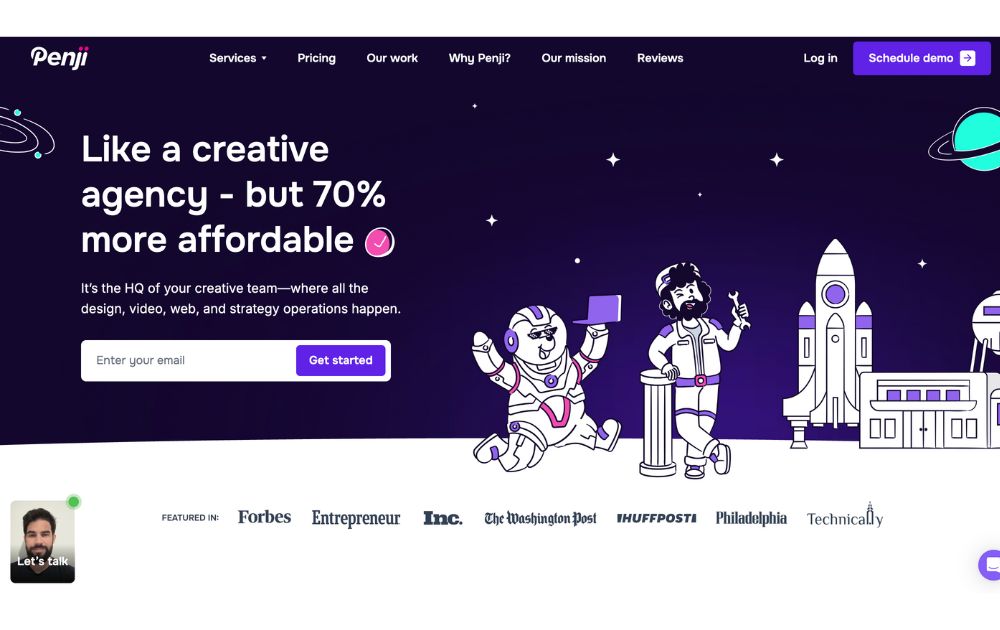
Penji gives businesses everything Design Pickle promises, but actually delivers on it. Designs come back in 24-48 hours (not 2-3 days), and clients get unlimited revisions until they’re happy with the result. The dashboard is dead simple to use—just upload a request, add some notes, and designers get to work.
What really sets Penji apart? Clients aren’t stuck with random designers each time. The team learns brand preferences, remembers style choices, and gets better with every project. Plus, if businesses need to pause during slow months, they can do that without losing their spot. See how Penji compares to other services.
2. Designjoy – Premium But Pricey
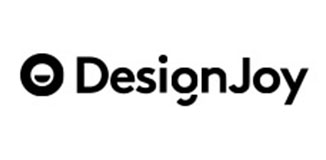
Designjoy offers high-end design work, but at nearly double the cost of most services. They’re great if budget isn’t a concern and companies only need one designer working on projects. The wait time can be longer since clients work with a single designer who might be juggling multiple accounts.
3. Superside – Better for Agencies
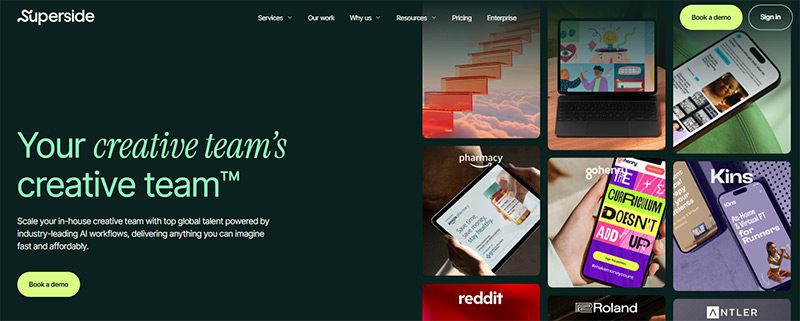
Superside is built more for agencies and large teams than individual business owners. They do solid work, but the onboarding process is complex and companies need to commit to higher-tier plans to get reasonable turnaround times.
Conclusion
After comparing all the major graphic design services, Penji remains the best Design Pickle alternative for business owners who want quality, speed, and value. Companies get professional designs without the enterprise pricing or frustrating delays.
Stop waiting around for designs. Try Penji today and see why thousands of business owners made the switch.
Frequently Asked Questions
Is Penji really faster than Design Pickle? A:
Yes. Most Penji designs are completed within 24-48 hours, while Design Pickle typically takes 1-2 business days or longer.
What if businesses don’t like the design?
Clients get unlimited revisions with Penji. Just leave feedback and designers will make the changes until everyone’s completely satisfied.
Do businesses need to sign a long-term contract?
Nope. Penji works month-to-month, and companies can pause or cancel anytime. Learn more about flexible plans.
Business
Top Marketing Podcasts for 2025 You Should Be Following Today
Published
6 days agoon
October 17, 2025By
Skylar Lee
Being a marketer means constantly being on the lookout for the latest in marketing trends and news. You’ll be surprised how fast trends come and go, along with the tools that you commonly use for your campaigns. If you’re looking for a trend that never goes out of style, it’s podcasting. Here are the top marketing podcasts to tune in to in 2025:
1. Marketing School

Marketing School is hosted by one of the famous names in the marketing industry: Neil Patel. Eric Siu is also another popular figure hosting the show. They update listeners on the newest marketing and SEO trends and information. Plus, they interview content creators and marketers to share their marketing secrets and tips to achieve their goals. It’s a great starter podcast for new marketers in the field. Listen to the famous hosts every day!
2. Social Media Marketing Podcast

The Social Media Marketing Podcast should be your go-to podcast if you’re focused on social media marketing. Listen to Michael Stelzner weekly to get the best tips on marketing on social media with the latest tech and trends. If you’re also running out of content ideas, the podcast host also provides tips and insights to help you get started on new strategies. Plus, he interviews marketers and business leaders on how they achieved success with social media marketing.
3. The WARC Podcast

The WARC Podcast delivers marketing insights to help you know the latest in marketing for the week. You’ll learn what marketing challenges marketers overcame. Listen to them twice a week for recent trends, interviews, and event recaps.
4. Duct Tape Marketing
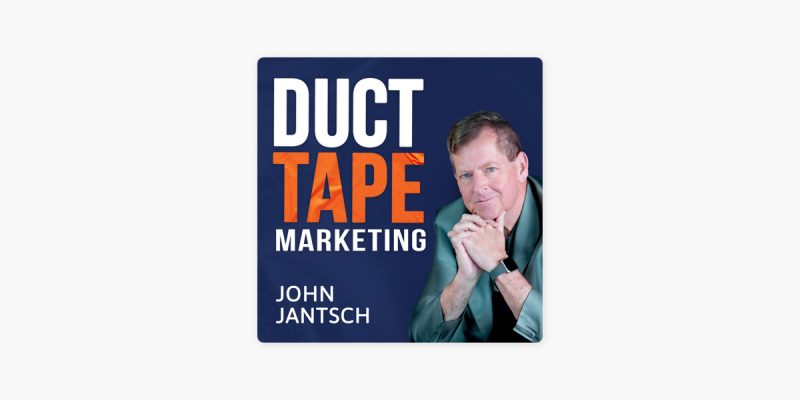
Another big name in the marketing sphere is Duct Tape Marketing, which made an impact in 2005. Listen to John Janstch three times a week to listen to interviews with small business owners and marketers, and how they grew their businesses through marketing strategies. Don’t miss out on the trends and tips to supercharge your marketing.
5. Perpetual Traffic
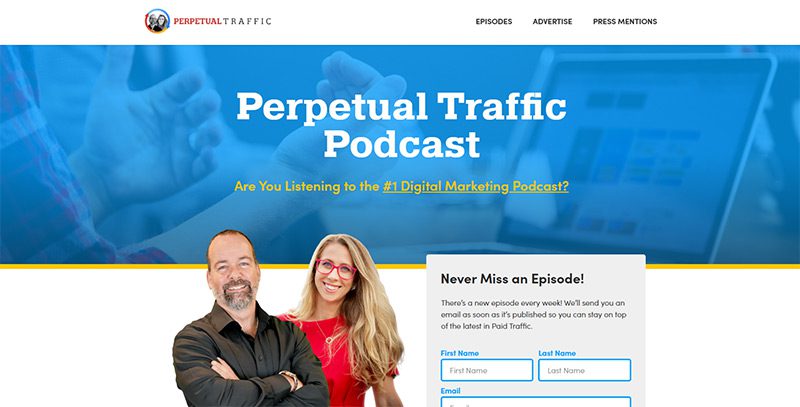
If you want tips from expert marketers Ralph Burns and Kasim Aslam, listen to Perpetual Traffic! They specialize in paid traffic tips to help you increase sales and leads! Expect interviews from various experts in different niches. You can also get insights from case studies to help you grow your business. Listen to them twice a week!
6. The Digital Marketing Podcast
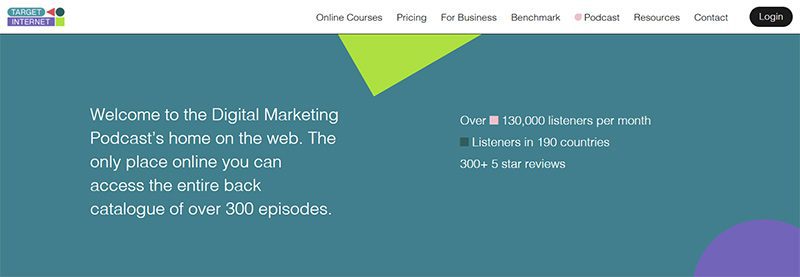
Do you want to be updated on everything digital marketing? The Digital Marketing Podcast is the best podcast to listen to. Know the latest news, updates, stats, and future of marketing. The hosts also discuss current tech trends in marketing to grow your business. Listen to the hosts twice a week!
7. The Affiliate Guy
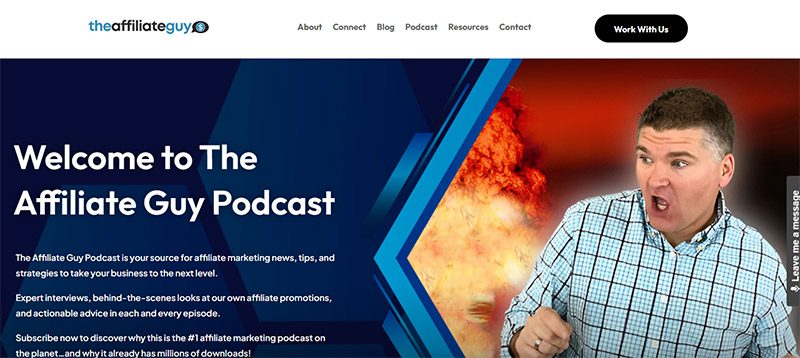
Are you an affiliate marketer and need expert advice and the latest updates on affiliate marketing? You should listen to The Affiliate Guy. Hosted by Matt McWilliams, he has trained over 320,000 affiliates.
Think of The Affiliate Guy’s podcasts as engaging audio versions of How-To blogs. Additionally, he interviews entrepreneurs and leaders. Plus, he also references case studies to help you understand how they achieved their goals.
8. Marketing Trends
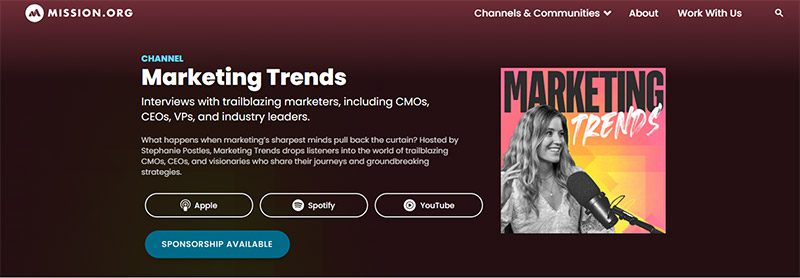
The very apt Marketing Trends podcast updates you weekly with new information and insights about marketing! You can listen to CEOs, CMOs, and other thought leaders share best practices and strategies to grow the biggest brands! Know how you can grow as a leader or an ambitious marketer when you get the latest tips for achieving success.
9. Stand The F*ck Out™
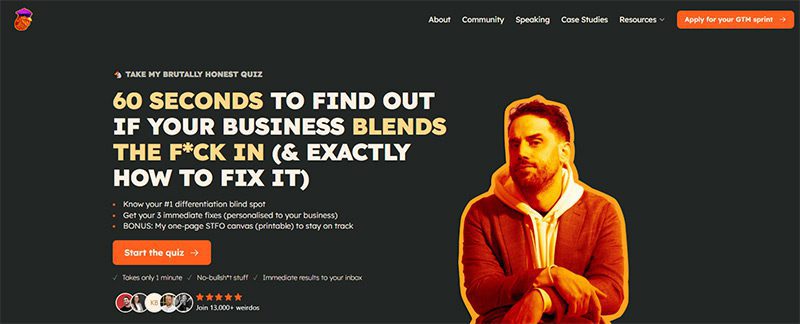
Are you tired of hearing or reading the same marketing tip or trend and don’t want to use that strategy anymore? Stand The F*ck Out™ gets straight to the point and doesn’t dilly dally when discussing marketing. Louis Grenier hosts the show and provides evergreen topics. You also get to hear from experienced marketers how their teams executed strategies and got the desired results. Listen to this podcast weekly.
10. Social Pros Podcast
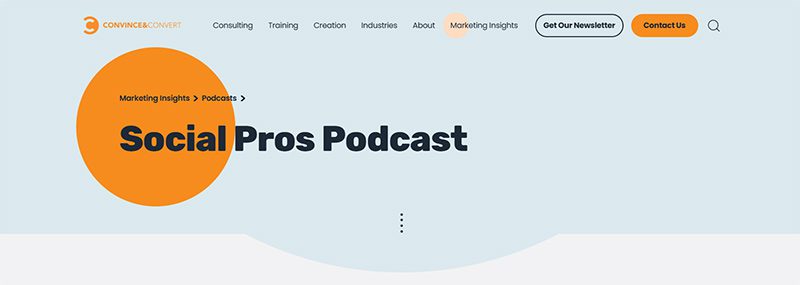
Are you interested in learning how social media marketers execute their campaigns for big brands? The Social Pros Podcast should be on your radar. Jay and Adam host the show, which you can listen to weekly. Not only do they discuss recent trends and strategies, but they also discuss team management and other personal conversations on being a marketer.
11. Marketing Over Coffee
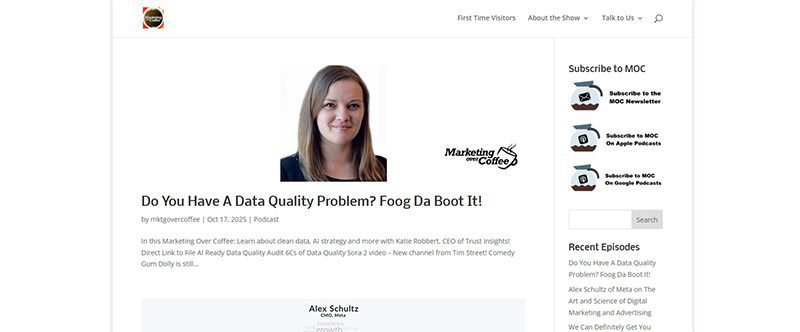
Do you prefer listening to podcasts in the morning during breakfast? Why not listen to Marketing Over Coffee on the side while enjoying a hearty morning meal? Like other podcasts, you’ll hear the latest tech trends like AI and improved marketing tools. Plus, get insights from the experts like Seth Godin, Rand Fishkin, and Ann Handley! Episodes come out weekly!
Business
What are the Best Social Media Post Design Services for Startups?
Published
7 days agoon
October 15, 2025
While startups have limited resources, it doesn’t mean they can’t enjoy high-quality graphics for their social media channels. Here are the best social media post design services that are affordable, fast, and efficient:
Penji

An on-demand graphic design service, Penji tops this list, thanks to its high-quality work, fast delivery times, and flexible pricing plans. It has a team of professional designers that can craft the most amazing social media graphics, logo designs, custom illustrations, and more for as low as $499 per month.
Kimp

A subscription-based design-as-a-service, Kimp offers unlimited graphic designs and videos for as low as $448 (for a limited time only). You can send as many design requests as you can in a month, revisions included. Its turnaround time is 1 to 2 business days, ideal for startups that need to post content regularly.
ManyPixels
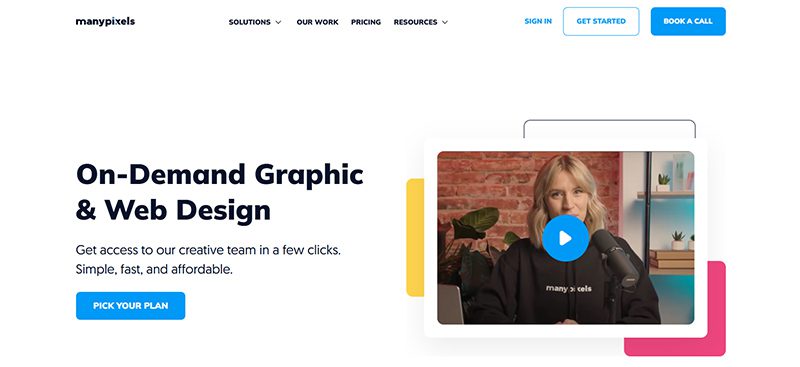
With all-inclusive plans starting at $599 per month, ManyPixels is an excellent option for startups seeking a reliable design solution. A subscription plan includes unlimited design requests, revisions, brands, free stock assets, native source files, and many other graphic design services.
Fiverr

One of the more popular platforms for social media post design services is Fiverr, a freelancer marketplace. Its global platform lets you choose a freelance graphic designer from around the world. You can find one based on their location, rates, expertise, and many other factors. Social media post designs usually start as low as $5 to $20.
Canva Pro

A cloud-based design platform, Canva Pro, has tools to let you create professional-quality social media posts for less. It has thousands of customizable templates, brand kits, and drag-and-drop features to help you boost your social media marketing. It offers a free trial, but if you want to enjoy more of its features, a $15 per month subscription fee is all you need.
What’s the Best Design Pickle Alternative?

Top Marketing Podcasts for 2025 You Should Be Following Today

What are the Best Social Media Post Design Services for Startups?

What’s the Best Package Design Service Agency?

What’s the Best Print Media Design Service Agency?
Don’t Sign Up for a Design Service Before You Read This

What’s the Best Website Design Company in 2025?
Don’t Sign Up for a Design Service Before You Read This

Top Marketing Podcasts for 2025 You Should Be Following Today

What’s the Best Website Design Company in 2025?

What’s the Best Print Media Design Service Agency?

What’s the Best Package Design Service Agency?
